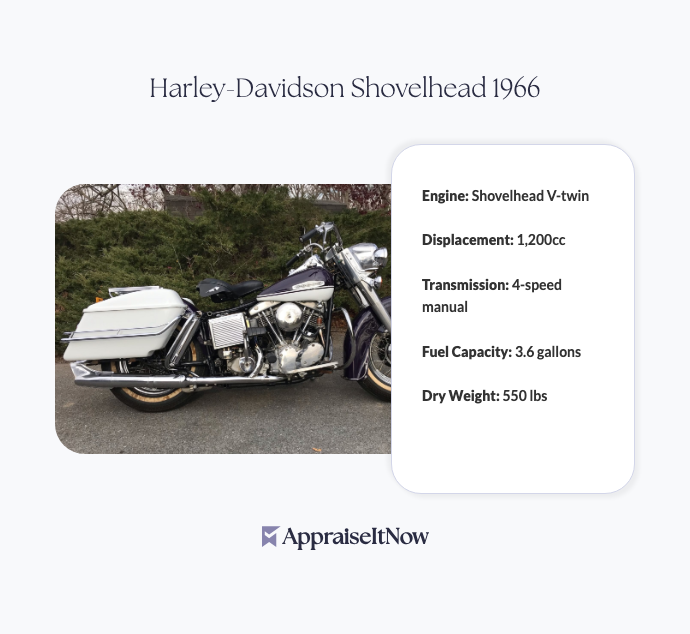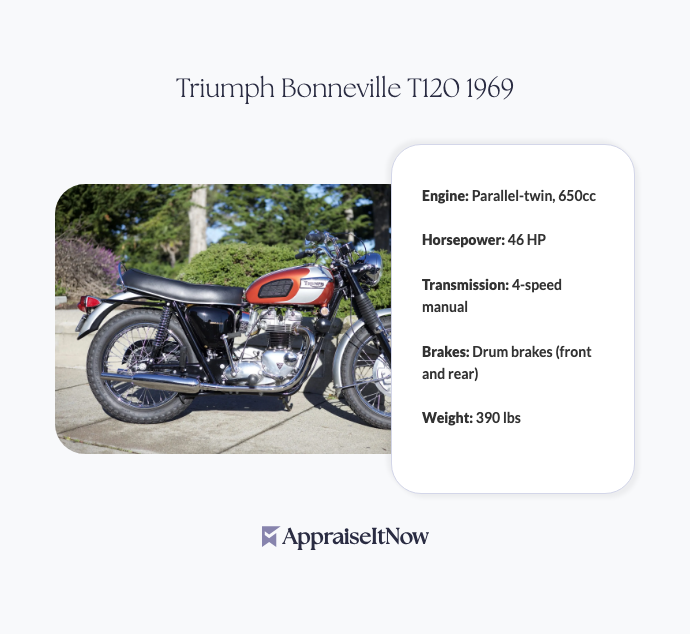<h1>How to Get Your Harley-Davidson Shovelhead 1966 Appraised</h1>
<p>If you own a 1966 Harley-Davidson Shovelhead, you're sitting on a valuable piece of American motorcycle history. Whether you're looking to sell, insure, or simply understand what your classic bike is worth, a professional appraisal is your first step toward accurate valuation. The 1966 Shovelhead typically commands <strong>$10,000 to $15,000</strong> in today's collector market, but determining your specific motorcycle's worth requires expert evaluation of condition, originality, and provenance.</p>
<h2>Understanding Your Shovelhead's Market Value</h2>
<p>The 1966 Harley-Davidson Shovelhead holds significant appeal in the collector's market for good reason. This iconic model introduced Harley's distinctive Shovelhead engine design—named for its shovel-shaped cylinder heads—which became synonymous with reliable, powerful V-twin performance. The motorcycle features a chrome-plated fuel tank, rugged steel frame construction, and an engine that produces the unmistakable rumble that Harley riders cherish. When collectors ask how much a 1966 Harley-Davidson is worth, the answer depends heavily on your bike's specific condition and documented history.</p>
<p>What makes the Shovelhead so sought-after by enthusiasts and collectors? Beyond its legendary engineering, the 1966 model year marks the beginning of an era. The Shovelhead engine ran from 1966 through 1985, making it one of Harley's longest-produced designs. However, first-year models carry premium appeal due to their historical significance and the engineering innovations Harley introduced that year. If you're evaluating your motorcycle's worth, understanding these distinctions helps establish realistic expectations for your appraisal.</p>
<div class="callout tip"><p><strong>Collector's Insight</strong></p>
<p>First-year 1966 Shovelhead models with matching numbers and original components often command 15-25% premiums over later variants.</p></div>
<h2>Key Factors That Impact Your Shovelhead's Appraisal Value</h2>
<p>A professional appraiser examining your 1966 Shovelhead will assess multiple dimensions beyond simple age or appearance. The condition of your motorcycle's engine—particularly the iconic Shovelhead itself—directly influences valuation. An engine in working condition with original cooling systems and unmodified internal components suggests careful ownership and maintenance history.</p>
<p><strong>Originality versus restoration</strong> represents one of the most significant value considerations. Does your Shovelhead retain its original paint and finishes, or has it undergone professional restoration? While quality restorations are valuable, original examples with patina often command premiums among knowledgeable collectors who view authentic wear as evidence of genuine history. The integrity of your chrome-plated fuel tank, frame welds, and component specifications all factor into the appraiser's assessment.</p>
<p>Documentation matters substantially when establishing value. Do you have original purchase records, maintenance logs, or proof of previous ownership? Service history demonstrating regular care and parts replacement patterns helps justify valuations within the higher end of the $10,000-$15,000 range. Collectors seeking <a href="/types/memorabilia-and-collectibles">memorabilia and collectibles</a> appraisals understand that provenance documentation transforms a motorcycle from an interesting vintage bike into a historically significant asset.</p>
<h2>Comparing Your Shovelhead to Other Harley Models</h2>
<p>When asking what the most collectible Harley-Davidson is, answers vary by collector preference and budget. The Shovelhead occupies a fascinating middle ground—more valuable than many post-1985 models, yet more affordable than rare pre-war Harleys or specialized competition bikes. The best year of Shovelhead depends on specific features, but first-year 1966 models and later Evolution-engine transitions create natural value peaks.</p>
<p>Your 1966 model predates many common Harley problems that emerged in later decades. The question of which Harleys hold their value best generally favors the Shovelhead era due to its proven reliability and the strong collector interest in late-1960s motorcycles. If you're curious about a 1960 Harley-Davidson's value or a 1965 Harley-Davidson's worth, those pre-Shovelhead models typically command different premiums based on Panhead engine configuration and styling distinctions.</p>
<div class="callout note"><p><strong>Market Context</strong></p>
<p>The Shovelhead's 20-year production run (1966-1985) created both abundance and specialization—certain years and configurations are far more valuable than others.</p></div>
<h2>Finding the Right Appraiser for Your Motorcycle</h2>
<p>Not all appraisers understand vintage motorcycles with the depth required for accurate valuation. When selecting an expert to assess your 1966 Shovelhead, look for credentials in <a href="/types/automobile">automobile</a> and <a href="/types/motorcycle">motorcycle</a> appraisals, preferably with specific experience in classic Harley-Davidson models. Your appraiser should be familiar with USPAP standards—the Uniform Standards of Professional Appraisal Practice—ensuring their valuation holds weight for insurance, legal, or financial institutions.</p>
<p>Professional appraisers specializing in <a href="/blog/appraising-classic-and-vintage-motorcycles-determining-collectible-bike-worth">classic and vintage motorcycles</a> can distinguish between genuine first-year features and later modifications. They'll verify engine numbers match the frame, assess the authenticity of replacement parts, and document the motorcycle's overall condition through detailed photography and written description. Unlike casual estimates from motorcycle shops, certified appraisers provide documentation that insurance companies, banks, and courts accept as authoritative.</p>
<p>AppraiseItNow connects you with credentialed experts across the United States who specialize in vintage motorcycle valuation. Our appraisers hold certifications from recognized organizations including the American Society of Appraisers (ASA) and can provide USPAP-compliant reports within days of submitting photographs and documentation.</p>
<h2>The Appraisal Documentation You'll Receive</h2>
<p>When you commission a professional appraisal of your 1966 Shovelhead, expect a comprehensive report documenting far more than a simple dollar figure. A quality appraisal includes detailed photographs showing the motorcycle from multiple angles, close-ups of the engine, frame, and any modifications or wear patterns. The appraiser will document specifications including engine number, frame number, and original factory options.</p>
<p>Your appraisal report should include comparable market analysis—examples of similar 1966 Shovelheads sold recently and their prices—establishing how your motorcycle ranks within the broader $10,000-$15,000 valuation range. The appraiser will note condition grade (ranging from poor to excellent), document any modifications from original specifications, and explain the reasoning behind the final valuation. This level of detail proves invaluable whether you're <a href="/blog/using-automobile-appraisals-for-insurance-purposes">using the appraisal for insurance purposes</a> or negotiating a sale price.</p>
<h2>Preparation Steps Before Your Appraisal</h2>
<p>You can maximize the accuracy of your appraisal by preparing your Shovelhead appropriately. Clean the motorcycle thoroughly but avoid aggressive restoration work immediately before appraisal—genuine patina often carries value, and aggressive cleaning can obscure original finishes. Gather any documentation including original purchase receipts, maintenance records, parts receipts, and previous appraisals or insurance valuations.</p>
<p>Organize photographs if you have historical images showing the motorcycle's condition over time. Compile any service records that demonstrate regular maintenance and care, as this narrative supports valuations at the higher end of the market range. If you've completed restorations or major repairs, collect receipts and documentation showing what work was performed and by whom. Professional shop work carries more weight than amateur modifications in appraisal assessments.</p>
<h2>Common Questions About Your Shovelhead's Value</h2>
<p>Collectors frequently ask whether specific modifications increase or decrease value. Custom paint jobs, aftermarket parts, and engine modifications typically reduce value compared to original specification examples, though exceptions exist for work completed by renowned customizers. The question of which Harleys hold their value best generally favors stock or lightly modified examples in good condition.</p>
<p>What year were Harleys bad? This question reflects concerns about specific production years plagued by quality issues, though the Shovelhead engine generally earned strong reliability marks during its entire production run. First-year engines sometimes have quirks as design innovations settle, but 1966 Shovelheads are respected rather than problematic.</p>
<p>If you're wondering whether your Shovelhead is actually worth appraising—perhaps questioning whether an older motorcycle justifies professional evaluation—consider this: proper documentation protects you in multiple ways. Insurance companies require appraisals for coverage, estate executors need valuations for distribution, and sellers benefit from certified documentation that justifies asking prices and builds buyer confidence.</p>
<div class="callout tip"><p><strong>Pro Tip</strong></p>
<p>Update your Shovelhead's appraisal every 3-5 years to reflect current market conditions, especially if you've completed maintenance or restoration work.</p></div>
<h2>Why Professional Appraisal Matters for Your Investment</h2>
<p>Your 1966 Harley-Davidson Shovelhead represents more than nostalgic transportation—it's a tangible asset with documented market value. Professional appraisal establishes that value with credibility that casual estimates cannot match. Whether you're <a href="/blog/what-you-need-to-know-about-personal-property-appraisals">appraising personal property</a> for insurance, estate planning, donation purposes, or sale preparation, a certified appraisal provides the foundation for every financial decision.</p>
<p>The most sought-after vintage motorcycle in any collection is typically the one documented with professional appraisal—not because the bike itself changed, but because certainty transforms uncertainty into confidence. When buyers encounter certified appraisal documentation, they gain assurance that price negotiations are grounded in expert analysis rather than hope.</p>
<div class="callout note"><p><strong>Key Takeaway</strong></p>
<p>A professional appraisal of your 1966 Harley-Davidson Shovelhead provides certified documentation of its $10,000-$15,000 value, protecting your investment and enabling confident decisions about insurance, sale, or estate planning with expert credibility that stands up to scrutiny.</p></div>







.avif)







